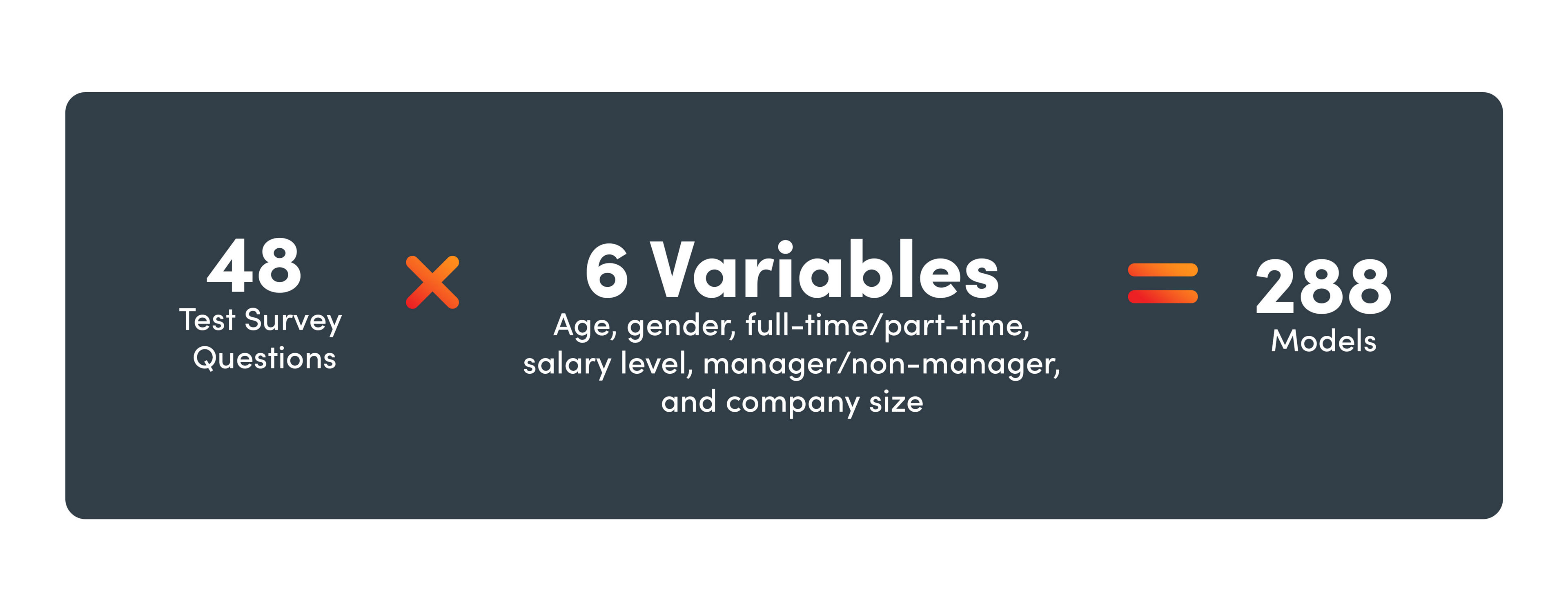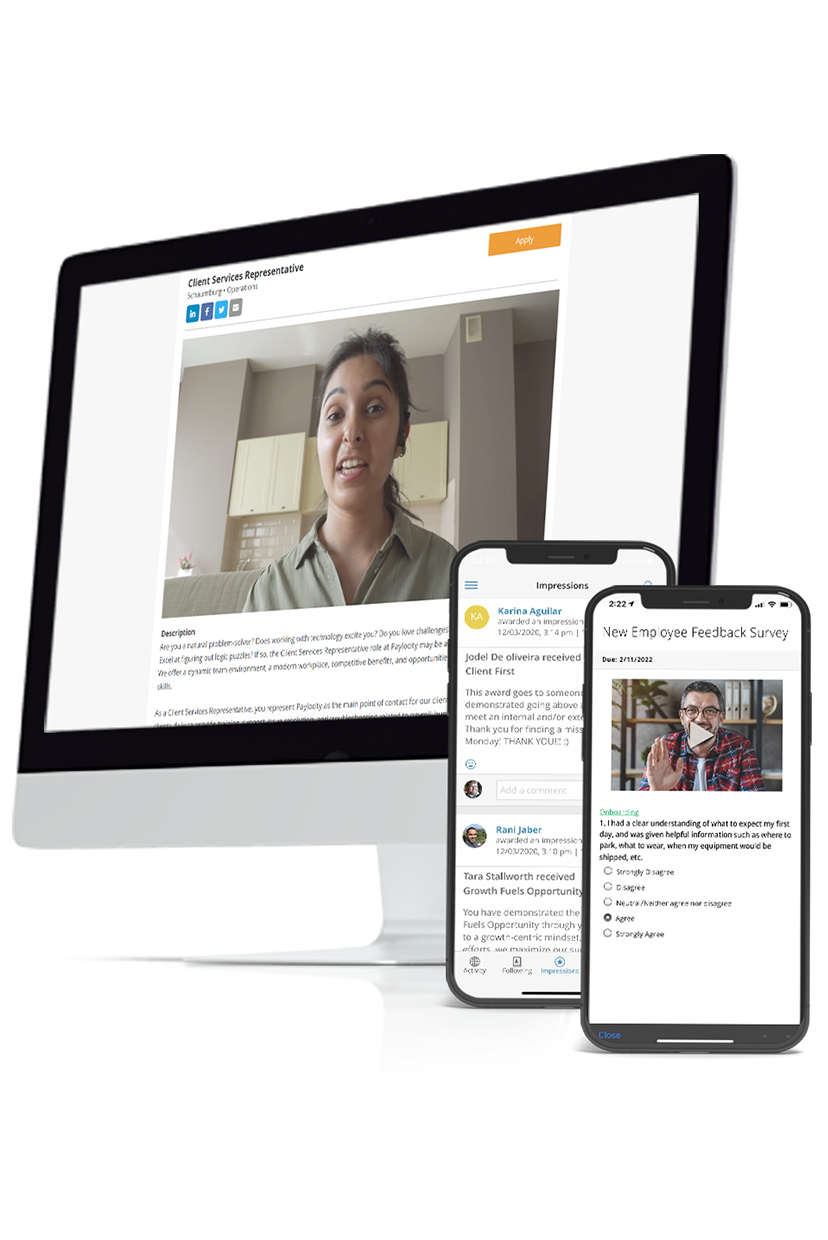
Demystifying Employee Engagement for Diverse Worker Populations
Is work-life balance as important to Gen Z as it is to Gen X? Do men and women value career opportunities similarly? Do managers appreciate recognition as much as non-managers?
Intuitively, we may expect some groups of workers to need very different things when it comes to employee engagement. But is that true?
Whether different companies should monitor the same engagement drivers across their worker population hangs on the answer to this question.
We conducted a study to find out if a single, well-refined survey instrument could effectively measure key drivers of employee engagement for diverse workforces. Our motivation was simple: To help us design a tool that would do the heavy lifting for HR teams and leaders who want to improve employee engagement across their organization, regardless of company size or demographics.
What we discovered might be a little surprising.
In this article, we’ll look at what our research reveals about whether different types of employees find any engagement drivers to be more or less important.
What Drives Employee Engagement?
Of course, determining what drives employee engagement is a complex question that HR professionals and researchers have been studying for years.
As SHRM notes, it’s even difficult to find a consistent definition for employee engagement, which often includes hard-to-quantify terms like “psychological investment” or “emotional connection.” This makes it challenging to pinpoint specific causes that could be leading to low engagement.
There are several common ways we tend to think about measuring employee engagement such as the Employee Net-Promoter Score (eNPS) or Paylocity’s engagement index. General metrics are helpful for evaluating overall whether employees feel engaged or not. But they don’t tell you why.
An “employee engagement driver” is an aspect of the employee experience that influences employee engagement. In the table below, you can see a list of various drivers that have been shown to be predictive of engagement. We set out to learn which, if any, of these drivers are more or less influential for different groups of employees.
|
Domain |
Driver |
|
Individual Experience |
Empowerment |
|
Work-Life Balance |
|
|
Inclusion |
|
|
Job Experience |
Enablement |
|
Peer Relationships |
|
|
Career Opportunities |
|
|
Organization Experience |
Recognition and Rewards |
|
Strategy Comprehension |
|
|
Manager Support |
How We Study Engagement Drivers
To design a versatile employee engagement survey that works for companies with a heterogenous workforce, we analyzed responses on 48 test survey questions across the nine drivers shown above, with employees characterized by six demographic variables: age, gender, full time or part time, salary level, manager or non-manager, and company size.
Here’s how that breaks down:

In total, we evaluated 288 models of employee engagement for approximately 1,000 participants!
We recruited high-quality online participants, ensuring that the demographics were distributed similarly to the U.S. working population and the Paylocity user population. We asked them multiple questions and calculated the average of their responses (an engagement index) to measure engagement levels for each driver.
Using a linear regression model, we then statistically evaluated if each driver is more important for one type of employee compared to another. In our models, we estimate a statistic that shows how much the correlation between an engagement driver and the engagement index varies based on a third variable (e.g., age or gender).
Our Findings: Drivers of Employee Engagement Are Remarkably Consistent
Across the 288 models we analyzed, we found no evidence of engagement drivers varying significantly for different types of employees.
What does this mean for HR leaders?
Let’s assume you have a diversified workforce — some are salaried and some are hourly, some are managers, some are part-time. Not surprisingly, you have a mix of male and female workers, both over and under the age of 35.
Do you need to survey different groups of employees with different survey questions to measure the engagement drivers most important to each?
No!
Our results indicate that companies can confidently use a single, carefully designed engagement survey tool — like Paylocity’s Employee Voice — to reliably measure the drivers that are important to all their employees.
As an example, let’s explore one model (out of the 288) to see what these engagement responses look like for a set of workers using age as the third variable.
Example Engagement Driver: Work-Life Balance for Different Age Groups
There’s been a lot of discussion about Generation Z entering the workforce. If we believe everything we hear, this digital native population has high expectations for their employers — from top-end technology to inclusion and belonging to business transparency.
Gen Xers, on the other hand, grew up with early iterations of personal computing and tend to be independent and flexible. We might expect this mid-career population to have different values when it comes to employee engagement compared to their younger counterparts.
Consider the engagement driver, Work-Life Balance, which we define as an employee’s ability to balance work duties with personal responsibilities and interests. A good work-life balance ensures that employees can fulfill their job requirements without compromising their personal life, reducing stress and burnout.
So, we wanted to know — how strongly do older employees value work-life balance compared to younger employees?
In an employee engagement survey, we might ask participants to what degree they agree or disagree with statements like these to measure work-life balance:
- My stress level is manageable.
- The balance between my work and personal commitments is right for me.
Our model estimated a statistic that indicates how much work-life balance is correlated with engagement for younger employees compared to the correlation for older employees. If there is a substantial difference, this statistic would be significantly different from zero.
What we found was that there is no significantly different correlation between desired work-life balance and engagement for younger versus older employees. In other words, on average, employees with higher work-life balance measure consistently higher on employee engagement regardless of whether they are older or younger.

These graphs clearly show that result — the correlation between work-life balance and engagement is nearly identical for younger and older employees.
This analysis on how work-life balance (the engagement driver) correlates with engagement for different employee ages (the third variable) is just one example of how we tested if engagement drivers are different for different groups. We conducted the same type of analysis for all combinations of the six demographics and 48 questions that we described above.
Conclusion: Employee Groups Share Similar Engagement Drivers
By analyzing multiple potential demographic variables that might have been associated with many different engagement drivers, we cast a wide net. We wanted to see if we could find any types of employees for whom any engagement drivers were more or less important.
We found zero statistically significant differences, which means that employees show remarkable similarity in what drives higher engagement.
This is not to say there are absolutely no differences. There are certainly some, if small, variations from population to population. But the practical question is whether the differences are large enough to require different engagement surveys for different employees. We concluded that a well-designed survey can effectively measure engagement drivers for any workforce.
Paylocity’s Employee Voice is built on this and other scientific research, such as our study on drivers of retention. This unique software tool does more than measure and monitor employee engagement — it also delivers recommendations based on your company’s scores for each driver so you can address specific areas for improvement. When organizations use Employee Voice, they can be confident they’re getting a full picture of engagement across all their employees.
There are many types of companies, which come in different sizes and provide different services. There are also many types of employees, who bring different experiences to the workplace and serve in different roles.
In the end, however, beneath these surface differences, companies are made up of people who are strikingly similar in what drives them to be engaged in their work.

Engage, Empower, and Elevate Your Workforce
Drive meaningful communication, collaboration, and connection across your organization with our all-in-one employee experience platform. Designed to be more than just an HR tool, it’s a platform your employees will use daily to engage with their work, their peers, and your company’s culture.


